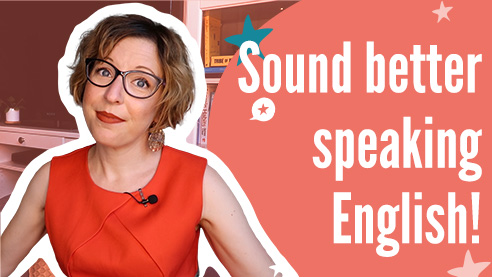
How to sound clear & interesting when you speak English
Intonation in English helps you speak clearly… And it helps you sound interesting!
You’ll sound more fluent if you use intonation well. If you get it wrong, it could be difficult to understand you, or worse, you might seem cold and rude.
And I’m sure that you’re a nice, interesting person! We don’t want your intonation to send the wrong message. The good news is: it’s easy to improve.
Today, let’s see 3 more different intonations, so you can practice and exercise.
Hi, I’m your English coach Christina, and welcome to Speak English with Christina: Step by step English lessons to help you learn faster, feel more confident, and reach your full potential. And today, like every week, I help you move one step closer to fluently speaking real American English. Let’s go!
Index:
1. Improve your intonation: Either/Or questions
2. Improve your intonation: Tag questions
3. Improve your intonation: Series
4. Improve your intonation: Recap to Remember
1. Improve your intonation: Either/Or questions
Either/Or questions are sentences that ask a question and give you a list of answers – and you can choose on these answers.
For example:
- Do you want to go with me or stay here?
- Are we going to the meeting or to lunch?
- Is the machine working or is it broken?
- Do they want to talk over the phone or meet in person?
- Is he in charge or just a spokesperson?
*** The extra mile:
to be in charge = to have the final responsibility, to be the one who makes the decision.
It’s one of those Essential Expressions for English Fluency !***
Last week we saw the intonation for 3 most common types of English sentences:
- Statements
- Yes/no questions
- Wh- questions.
Well, for either/or questions, we find the same intonation as for wh- questions!
The intonation rises on the first proposition (underlined below):
- Do you want to go with me or stay here?
- Do they want to talk over the phone or meet in person?
- Is he in charge or just a spokesperson?
- Are we going to the meeting or to lunch?
- Is the machine working or is it broken?
- So it’s a bit louder, and a bit higher in pitch.
Then the intonation falls on the second proposition (underlined below):
- Do you want to go with me or stay here?
- Do they want to talk over the phone or meet in person?
- Is he in charge or just a spokesperson?
- Are we going to the meeting or to lunch?
- Is the machine working or is it broken?
This part is a bit lower and quieter.
This will become automatic, and it’s a sign that you’re on your way to Master Real American English!
2. Improve your intonation: Tag questions
Tag questions have a different intonation. Tag questions are the short yes/no questions that sometimes show up at the end of a statement.
*** The extra mile:
to show up = to be present, to appear.
It’s always useful to learn these English chunks, so you can increase your vocabulary in English !***
For example, Tag questions can be the little “isn’t it?,” “don’t you?,” “can we?,” or “aren’t they?” at the end of the sentence. They’re pretty common in English.
*** The extra mile: how to build a tag question.***
→ Find the verb in the statement. If it’s not a modal verb (like “be”, “have”, “can”, “would”, “will”, “do”…), use “do” instead. (Reminder: you can use Would (and “used to”) to talk about the past in English.)
→ If it’s at the negative, put it in the affirmative. If it’s in affirmative, put it in the negative.
→ Find the subject. Take its pronoun (“it / they / you”…) and add it after the tag verb.
→ Add an interrogation point.
For example:
- “You like cats.” → “You like cats, don’t you?”
- “Michelle is here.” → “Michelle is here, isn’t she?”
- “These computers have extra security.” → “These computers have extra security, haven’t they?”
- “We can give it a try.” → “We can give it a try, can’t we?”
- “They’re ready to go.” → “They’re ready to go, aren’t they?”
You might know this already, but you need to make it a reflex if you want to Master Real American English.
*** *** ***
For a sentence with a tag question at the end, the intonation comes in 3 parts.
→ First, the intonation rises at the end of the statement
→ Then it falls at the beginning of the question
→ Finally, it rises again at the end, to make it sound interrogative.
In short, you can stress the words underlined below by saying them a bit louder and a bit higher:
- “You like cats, don’t you?”
- “Michelle is here, isn’t she?”
- “These computers have extra security, haven’t they?”
- “We can give it a try, can’t we?”
- “They’re ready to go, aren’t they?”
You can hear me say sentences with tag questions in the video lesson, so you can listen to the intonation. Repeat after me, and practice your intonation!
With practice it can become natural quickly. Can you hear the intonation changing?
3. Improve your intonation: Series
Finally, lists (or series) are sentences that… list things.
For example:
- “I want to help others, enjoy my work, and have fun.”
- “This soup is made with celery carrots, onions, and potatoes.”
- “You will cover our activities in France, Belgium, and Switzerland.”
- “I understand intonation, feel more confident and want to practice now.”
These series have a special intonation pattern too. Fortunately, it’s pretty easy!
→ Intonation goes up on the first thing in the list.
→ Intonation goes up on each of the next items in the list.
→ Intonation falls down on the final item of the list (at the end of the sentence.)
It ends like a normal statement! This falling intonation says to your listener “Hey, this is the end of my list!”
You can hear me use that intonation in an example in the video lesson. So you can repeat after me! Practicing rules (like in Master Real American English) will make you learn a lot faster.
4. Improve your intonation: Recap to remember
Here are the three intonations we’ve seen today!
- Either/Or questions → Rises on the first proposition, falls down on the second.
- Tag question → Rises at the end of the statement, rises again at the end of the question.
- Series → Rises on each item on the list, except the last one where it falls down.
Every type of sentence has its own intonation, and it can change depending on what you want to communicate. Now you can start paying attention to English intonations, and learn faster by observing, noticing, and especially practicing! Both learning and practice are key, and that’s what you’ll find in Master Real American English.
I have a short playlist to help you practice spoken English: you’ll find three more intonation exercises, fun games to pronounce common difficult English words correctly, and a lesson about everyday shortcuts in oral English. Everything you need to start speaking with confidence!
Click on the link to get started:
English Pronunciation Games
Gonna, Gotta, Wanna
Improve your Intonation – Part 1
I’ll see you in the next lesson!
More good stuff...
Click the image to learn more








Thanks for email me american accent survival kits. It really works well to me and i have only little bit problem in understanding fast american. I have a problem in understanding american slang words and phrases which mostly i can get to face while i am watching american movies. Even my dream is to go us and live in there with my family and that’s why i have been working hard to learn American english.Thank you again to help me learning american english. I wanna join your online english tutorial classes, can you please sent me your online class time table and fees structure to my email?